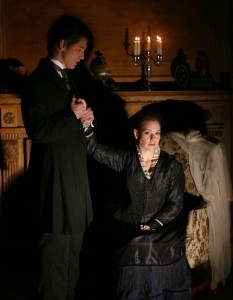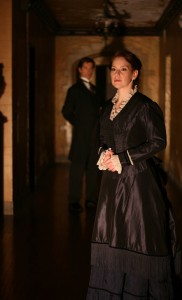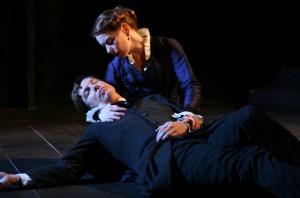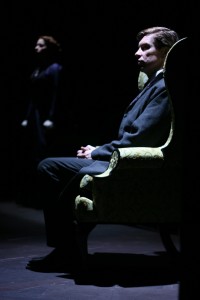HAUNTINGLY INTIMATE
Ghost stories are difficult to bring off on stage. The physical reality of flesh and blood actors works against the sense of the supernatural and the suspense and horror that give the genre its distinctive flavor. That’s why ghost stories are generally more effective on the printed page or in the movies or on the radio where the proximity of real people acting out the stories doesn’t disrupt the viewer’s willingness to accept the impossible.
 The First Folio Theatre is staging one of the few really stageworthy ghost stories in the modern theater, and presenting it in an impressively convincing production. The play is the Jeffrey Hatcher adaptation of Henry James’s 1898 short novel The Turn of the Screw. James’s tale has fascinated readers and critics for generations, not only because it is a true chiller but because there is no consensus that it is even a ghost story.
The First Folio Theatre is staging one of the few really stageworthy ghost stories in the modern theater, and presenting it in an impressively convincing production. The play is the Jeffrey Hatcher adaptation of Henry James’s 1898 short novel The Turn of the Screw. James’s tale has fascinated readers and critics for generations, not only because it is a true chiller but because there is no consensus that it is even a ghost story.
The story is set in 1872 in Victorian England. A young woman is interviewed by a wealthy London bachelor who seeks a governess to take complete charge of his young niece and nephew living in isolation on a country estate. The young woman accepts the job, partly because she has fallen in love with her employer at first sight and naively hopes for a relationship between them leading to marriage.
 The narrative covers the first seven days of the governess’s tenure on the estate. She immediately tries to bond with her two young charges, 6-year-old Flora and 10-year-old Miles. The only other resident on the estate is a housekeeper named Mrs. Grose. The governess soon learns that the preceding governess, Miss Jessel, drowned in the lake on the estate and soon afterward the estate steward, Peter Quint, was found dead by the children after he fell from a tower on the property.
The narrative covers the first seven days of the governess’s tenure on the estate. She immediately tries to bond with her two young charges, 6-year-old Flora and 10-year-old Miles. The only other resident on the estate is a housekeeper named Mrs. Grose. The governess soon learns that the preceding governess, Miss Jessel, drowned in the lake on the estate and soon afterward the estate steward, Peter Quint, was found dead by the children after he fell from a tower on the property.
Through the housekeeper, the governess hears that Jessel and Quint had, what would be called in prissy Victorian terms, an illicit relationship. The governess soon sees apparitions of Quint and Jessel and comes to believe that the two are malignant forces trying to entrap the children. The governess sets herself up as the protector of Miles and Flora against these forces of evil, leading to a tragic conclusion.
 The story is told mostly through a diary kept by the governess and much of the narrative is seen through her eyes. The story can be taken two ways: either Quint and Jessel were indeed ghosts bent on harming the children or the whole saga is the product of the governess’s fevered imagination. There are suggestions that the young woman is sexually repressed, the victim of an abusive childhood and caught in the web of warped Victorian attitudes on sexuality.
The story is told mostly through a diary kept by the governess and much of the narrative is seen through her eyes. The story can be taken two ways: either Quint and Jessel were indeed ghosts bent on harming the children or the whole saga is the product of the governess’s fevered imagination. There are suggestions that the young woman is sexually repressed, the victim of an abusive childhood and caught in the web of warped Victorian attitudes on sexuality.
 Flora and Miles outwardly are angelic children but there are deep waters there. Miles has just been expelled from his school for “unspeakable” offenses never explained, though there are hints his dismissal had homosexual roots. The governess quickly shows an interest in Miles with an undercurrent of eroticism.
Flora and Miles outwardly are angelic children but there are deep waters there. Miles has just been expelled from his school for “unspeakable” offenses never explained, though there are hints his dismissal had homosexual roots. The governess quickly shows an interest in Miles with an undercurrent of eroticism.
James never was definitive about how his story should be interpreted, and he loads it with ambiguities. Overall the author leaves the details of his tale to open-ended interpretations, enticing the audience to fill in the blanks with their own imagination.
Hatcher boils the story down to 90 interrupted minutes of intense stage time. He wrote the drama for two actors, a woman who plays the governess and a man who assumes all the other roles, including the London bachelor, the housekeeper, and Miles. This is Chamber Theater at its most intimate, well suited to the First Folio venue in the Gothic-flavored hall on the Mayslake Peabody Estate.
The story is told in extended monologues taken from the governess’ diary and in scenes between the woman and another character. The multi-level set (designed by Christopher Jensen) basically consists of a single chair and thick black drapes that enclose the playing area. Eerie lighting (designed by Michael McNamara) enhances the atmosphere. The sinister sound designed by Christopher Kriz further underscores the spooky mood. Emily Waecker designed the period costumes that establish the high Victorian sensibility of the story.
The cast consists of Melanie Keller as the governess and Nick Sandys as the other figures in the play. Sandys is superb in morphing from character to character with only subtle shifts in vocal inflection and body language. Once the audience recognizes the conventions of the staging, it requires no great leap of faith to accept Sandys in whatever character he assumes.
Keller is very good as the governess, possibly fighting a heroic battle against wicked spirits and possibly in the grip of her own disordered mind. Keller builds the rising hysteria in the governess, tilting the audience toward a perception that the ghosts are really the product of her sex-driven fantasies.
Alison C. Vesely orchestrates the production with appropriate nuance, avoiding false notes of melodrama that would rupture the fabric of the story. Some viewers will praise the acting but consider the story improbable to the point of silliness. But a good ghost story doesn’t visit local stages very often, one that depends on subtlety rather than shock effects. The opening night audience certainly seemed to buy into the play. You could hear a pin drop during its 90-minute duration, a sure vote of confidence for this kind of niche drama.
photos by D. Rice
The Turn of the Screw
First Folio Theatre in Oakbrook (Chicago Theater)
scheduled to end on April 29
for tickets, call 630 986 8067 or visit http://www.firstfolio.org
for info on this and other Chicago Theater, visit http://www.TheatreinChicago.com

